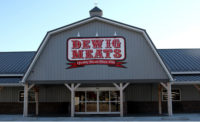It seems an obvious part of any business model that a company needs to have an online identity. Less obvious is exactly how to establish that identity. There are dozens of directions a company could take online. Taking a scattershot approach and trying to do everything at once — here’s a website and Facebook and Twitter and Snapchat and this and that — can be time consuming and ineffective. Taking time to ask a few key questions first (Who is my target audience? What is their preferred means of communication? What should my tone be?) pays off in the long run.
Danette Amstein, principal at Midan Marketing, sat down with me at the Annual Meat Conference in Nashville, Tenn. to talk about the digital world and how to succeed in it.
Sam Gazdziak: So how is the digital landscape shaping how consumers are making their real world purchases at the grocery store?
Danette Amstein: So Sam, for your audience I think it's important for them to realize that what's happening in the digital space, what consumers were looking at on their phones, or their tablets or their computers is directly influencing what they decide to shop for. And we've seen that slowly grow, but this year we've hit 51% of consumers say, "I am influenced by what I see or read in the digital space." So for smaller packers and processors that have brands and are not participating in that space, they're losing out on the opportunity to influence the consumer before they ever get to the store.
SG: Why should businesses in this industry be putting resources into the digital marketing? Are there specific areas that they should be focusing on?
DA: It can certainly be overwhelming, right? So when we work with a client or we do presentations, we talk about the number one thing you need to do: understand who your target is. Because we know we can't be all things to all people. And most companies will say, "Well, everybody needs my product." Well, that can be the case, but usually there is a smaller group versus everyone, right? If you understand who that target is and you find key messaging to talk to that target, then that's when you can start to create a relationship, and the digital platform space really helps you do that.
Because depending on who the target is, they may be in a different platform. I don't recommend that companies say, "I need to be in the digital space, I'm going to start on Facebook or I'm going to start on Twitter." No, it should really be based on who you're targeting to develop a community relationship with to engage and tell your brand, your product's, your company's story in order for them to want to purchase your product.
Fifteen or 20 years ago, websites were the new thing, right? Well, they are what we call table stakes now; you have to have a website. And a few years ago digital was the new thing. Not anymore. It's an expected platform by which our consumers expect to be able to find information, ask questions, engage with companies. And if you're not in that space, it says something to the person that might be interested in your products, and that's typically not a positive message.
SG: When we're talking about digital, are we talking about everything from websites through the latest social media and beyond?
DA: At Midan we like to think of it as a wagon wheel, and the hub of that wagon wheel is a website. And depending on who you're targeting in your products and what you need to accomplish through your digital strategy, determine how many spokes you have going out to the outer side of that wheel. And around the outer side of the wheel it might be just Facebook, or it might be Facebook and Instagram, or it might be Facebook, Instagram, and Pinterest depending on who your target is. If showing off beautiful pictures of your product cooked and as part of a meal is an important strategy to gain customers, then better be on Instagram because that's where a lot of that's happening, right?
If it's more about the unique aspects, and your customers are more of someone who spends their time going through news feeds on Twitter, then figure out how to be there. One of the great things about the digital space is it allows you to be in front of the customer 24/7 without having to expend energy 24/7 to do it — as long as you're focused on being in the right place for your customers to find you when they are interested in you, or you're using some of the advertising and posting strategies that exist to be in front of them at the right time and right place as well.
SG: As far as the messaging goes, I know there's a right way and a really wrong way to get the message out. So when you're talking about this kind of industry, what is the type of message that they should be trying to go with?
DA: Number one is to tell the story. Tell the company story. But it's important to figure out also what platforms inside the digital space you're using that you're authentic and you're consistent. So what you say on Twitter needs to match what you say on your website, which needs to match the message that might be on Facebook. That needs to be very consistent message and a consistent look and feel across so that it creates a relationship with your potential customers. Depending on what you wanted to accomplish and depending on what your product is, maybe you need to educate. It may be that you need to inform, it may be that you need to be proactive against what could be negative. In the meat industry we have products to fit in all three of those categories.
I'm seeing some companies that we would probably call disruptors because they're new, and they're different, and they're thinking about it differently, and they're taking very non-traditional tactics to reach consumers. But that's working really well for consumers. If you look at the “Beef It's What's for Dinner” campaign, and their relaunch in October, and they have kind of a more edgy tone to it. They've said, "How do I get the Millennials interested in farming, and ranching?" And they've kind of picked up their tone to do that. There used to be things the industry didn't talk about and now NAMI has videos on glass walls and all sorts of things to tell the story so that we can educate the consumers that want to be educated.
SG: I know some companies have done really well with an edgier kind of message. Wendy's has become kind of famous for it. That's really easy to mess up if you don't have it right. Is that more of an advanced level of social communication?
DA: It is, and it takes already having the right platform in place and that community in place so that you've already had time to study your community and your target, and you can test some things with them and see how they respond to it. I wouldn't recommend starting with edgy because it can be tremendously successful, but it also comes with a certain amount of risk.
I think if you go back and you look over the history of what Wendy's has done, it started in a much more conservative way. And as they engaged and listened to their audience, they were able to try some things here and there and say, "Okay, our community really responded positively to that. So now let's take another step into this new direction." I commend them because it looks fun from the outside, but I know they work hard to be in the right place at the right tone. Tone is everything, right? And we have to work in the digital space to make sure that that tone works across platforms, otherwise you end up with schizophrenic brands.
SG: You mentioned the industry may be taking a proactive role against some people who would be against the meat industry or against animal agriculture. What do you think are ways that the industry as a whole or companies can utilize this medium to get that message across?
DA: For years the meat industries have had a tendency to be more silent, right? And as we see the consumers shift and wanting to know more about what's in their food, and where their food is raised, and about the people that raised their food, we find ourselves in a unique position to tell real stories.
Activists like to pinpoint what they either claim is an issue or a problem and really go at it. And that becomes a problem for companies when they don't have the credibility with their consumer base to then be able to explain the situation. Our recommendation is always be ahead of that and have your digital channel, your platforms in place and be communicating so that you're gathering a community of folks that believe in your products and your company. So that when — not if it's when — an activist singles out a product that you own or comes after your company for some reason, you've got the credibility because of what you're already doing to say, "You know what? Let me explain this."
We are in a generation of people that want to know the why behind everything, and we find often that when we explain the why people are like, "Oh, okay." And we can usually dampen a lot of things that could become activist issues or just blown out of proportion. We don't have to do that, but often if we haven't done the proactive step of engaging consumers and telling our story, then we don't have the credibility to go where we need to go.
SG: So for a lot of my smaller readers who maybe unsure about how to dip their toe into this massive pool, what advice would you have on how they can kind of get started?
DA: Start small. Don't try to eat the whole pizza at one time, right? Figure out where you can have the biggest impact with the smallest amount of work, and start with one brand or one area of the company. When we work with our clients, it's about where can we have the biggest impact with the least amount of time. That's what small companies don't have, is time and resources. There is a brand new e-book on our website that we just published. It's called "Connect Five: A Step-by-Step Guide to Digital Marketing". That, I think, might be a good place for some of your readers to start. "Okay. I know I need to be in the space, it's time for me to jump in. What am I gonna do?" This will at least help them put together a game plan to do that.
SG: In your opinion, what is one thing that a company should be doing in 2018 to ensure that they have a successful year?
DA: So if I was going to go with the only one, it's be sure to understand your consumer. I think in the meat industry, we often create products because of the equipment we have, or the technology we have access to, or the byproducts we have left over. All valid reasons, but we can expend a tremendous amount of energy and have less than optimal success because we haven't included taking time to think about who's going to buy it, and how we're going to reach them, and what's going to get them excited to either order it off of a menu or put it in their cart. I guess the best advice I can give is think about who the true consumer, we call it the persona, is so that you can build backwards. What's a need you're going to solve for? Who is that that has that need, and how can you reverse-engineer back to the things you have in your facility to meet that need?
If I was going to tie this into digital space I would say do something. Don't let this year go by and not have established some sort of digital presence that is bigger than a website.






Report Abusive Comment